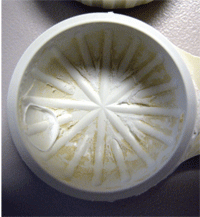 Eye care practitioners have made various recommendations over the years on how to best care for lens cases. These suggestions can range from running the case through the dishwasher to boiling, disinfecting or replacing the case, but more frequently than not, practitioners avoid making a recommendation at all. Contact lens manufacturers and the Food and Drug Administration (FDA) recommend rinsing the case with multipurpose disinfecting solution (MPDS) and air drying.1 Unfortunately, this method has not been scientifically evaluated and may lead to biofilm formation from both pathogen contamination and solution evaporation, which may put the patient at risk for infection or inflammation.2-8
Eye care practitioners have made various recommendations over the years on how to best care for lens cases. These suggestions can range from running the case through the dishwasher to boiling, disinfecting or replacing the case, but more frequently than not, practitioners avoid making a recommendation at all. Contact lens manufacturers and the Food and Drug Administration (FDA) recommend rinsing the case with multipurpose disinfecting solution (MPDS) and air drying.1 Unfortunately, this method has not been scientifically evaluated and may lead to biofilm formation from both pathogen contamination and solution evaporation, which may put the patient at risk for infection or inflammation.2-8
Evidence supporting the risk of lens case biofilm-related infections has been very strong, but there has been little evidence-based data to suggest which hygiene regimes are effective in removing the biofilm. A new study by Y.T. Wu, Ph.D., and colleagues, printed in the April 2011 issue of Investigative Ophthalmology and Visual Sciences, looked at biofilm removal of two common ocular pathogens, Staphylococcus aureus and Pseudomonas aeruginosa.2
This study evaluated various cleaning methods using two lens solutions—Opti-free RepleniSH (Alcon) and Complete (Abbott Medical Optics)—and the lens cases associated with these solutions. The lens cases, ridged and smooth wells, were inoculated with a bacterial suspension and incubated for 24 hours to encourage biofilm formation. The study then compared five different lens case care regimes: control group of unclean lens cases; the manufacturers’ guidelines of rinse with MPDS and air dry; rub with a gloved finger, rinse with a MPDS or water and air dry; tissue wipe the well; and rub with a gloved finger, rinse with a MPDS or water, tissue wipe and air dry.

Biofilm, seen or unseen, can only be removed by mechanical disruption, such as wiping with a tissue.
Irrespective of the rinsing solution and the bacterial strains tested, each cleaning regimen showed a significant reduction of biofilm compared to the control (p < 0.05).2 Overall, fewer bacteria were recovered from cases cleaned with Opti-free RepleniSH. However, rubbing and rinsing with an MPDS—followed by tissue wiping and air drying—was most effective in removing the biofilm of the bacterial strains in this study, regardless of the MPDS used. Just small amounts of biofilm were removed by the manufacturer’s recommendations.2
Regardless of cleaning method, biofilm was easier to remove from a smooth case than a ridged case (p<0.001). While tissue wiping alone reduced the biofilm in smooth cases, the irregular surface of the ridged well may shelter pathogens from mechanical shearing forces, making rubbing and tissue wiping necessary for a significant reduction of biofilm.2
This study demonstrated that lens case biofilm contamination is affected by the care regime, the well design and the disinfection properties of the MPDS. While continued study is needed, it is one of the few reports with clearly defined, real-life evidence based recommendations on lens case care.
1. Focusing on Contact Lens Safety. FDA. 2008 Nov. Available at:
www.fda.gov/ForConsumers/ConsumerUpdates/ucm048893.htm (Accessed April 2011).
2. Wu YT, Zhu H, Willcox M, Stapleton F. The effectiveness of various cleaning regimens and current guidelines in contact lens case biofilm removal. Invest Ophthalmol Vis Sci. 2011 Apr. [epub ahead of print]
3. Wu YT, Zhu H, Willcox M, Stapleton F. Removal of biofilm from contat lens storage cases. Invest Ophthalmol Vis Sci. 2010 Dec;51(12):6329-33.
4. Szczotka-Flynn LB, Pearlman E, Ghannoun M. Microbial contamination of contact lenses, lens care solutions and their accessories: a literature review. Eye Contact Lens. 2010 Mar;36(2):116-29.
5. Kilvington S, Powell CH, Lam A, Lonnen J. Antimicrobial efficacy of multi-purpose contact lens disinfectant solutions following evaporation. Cont Lens Anterior Eye. 2011 Mar. [epub ahead of print]
6. Ahearn DG, Zhang S, Stulting RD, et al. In vitro interactions of fusarium and acanthamoeba with drying residues of multipurpose contact lens solutions. Invest Ophthalmol Vis Sci. 2011 Mar;53(3):1793-9.
7. Szczotka-Flynn LB, Imamura Y, Chandra J, et al. Increased resistance of contact lens-related bacterial biofilms to antimicrobial activity of soft contact lens care solutions. Cornea. 2009 Sep;28(8):918-26.
8. Tam C, Mun JJ, Evans DJ, Fleiszig SM. The impact of inoculation parameters on the pathogenesis of contact lens-related infectious keratitis. Invest Ophthalmol Vis Sci. 2010 Jun;51(6):3100-6.


